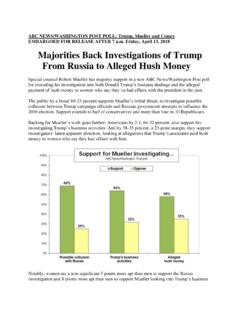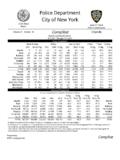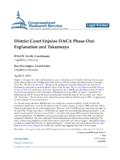Transcription of The North American Free Trade Agreement (NAFTA)
1 The North American Free Trade Agreement (NAFTA) M. Angeles Villarreal Specialist in International Trade and Finance Ian F. Fergusson Specialist in International Trade and Finance May 24, 2017 congressional research Service 7-5700 R42965 The North American Free Trade Agreement (NAFTA) congressional research Service Summary The North American Free Trade Agreement (NAFTA) entered into force on January 1, 1994. The Agreement was signed by President George H. W. Bush on December 17, 1992, and approved by Congress on November 20, 1993. The NAFTA Implementation Act was signed into law by President William J. Clinton on December 8, 1993 ( 103-182). The overall economic impact of NAFTA is difficult to measure since Trade and investment trends are influenced by numerous other economic variables, such as economic growth, inflation, and currency fluctuations.
2 The Agreement likely accelerated and also locked in Trade liberalization that was already taking place in Mexico, but many of these changes may have taken place without an Agreement . Nevertheless, NAFTA is significant, because it was the most comprehensive free Trade Agreement (FTA) negotiated at the time and contained several groundbreaking provisions. A legacy of the Agreement is that it has served as a template or model for the new generation of FTAs that the United States later negotiated, and it also served as a template for certain provisions in multilateral Trade negotiations as part of the Uruguay Round. The 115th Congress faces numerous issues related to NAFTA and international Trade . On May 18, 2017, the Trump Administration sent a 90-day notification to Congress of its intent to begin talks with Canada and Mexico to renegotiate NAFTA, as required by the 2015 Trade Promotion Authority (TPA).
3 The administration also began consulting with Members of Congress on the scope of the negotiations. Alternatively President Trump, at times, has threatened to withdraw from the Agreement without satisfactory results. Congress may wish to consider the ramifications of renegotiating or withdrawing from NAFTA and how it may affect the economy and foreign relations with Mexico and Canada. It may also wish to examine the congressional role in a possible renegotiation, as well as the negotiating positions of Canada and Mexico. Mexico has stated that, if NAFTA is reopened, it may seek to broaden negotiations to include security, counter-narcotics, and transmigration issues. Mexico has also indicated that it may choose to withdraw from the Agreement if the negotiations are not favorable to the country. Congress may also wish to address issues related to the withdrawal from the proposed Trans-Pacific Partnership (TPP) free Trade Agreement among the United States, Canada, Mexico, and 9 other countries.
4 Some observers contend that the withdrawal from TPP could damage competitiveness and economic leadership in the region, while others see the withdrawal as a way to prevent lower cost imports and potential job losses. Key provisions in TPP may also be addressed in modernizing or renegotiating NAFTA, a more than two decade-old FTA. NAFTA was controversial when first proposed, mostly because it was the first FTA involving two wealthy, developed countries and a developing country. The political debate surrounding the Agreement was divisive with proponents arguing that the Agreement would help generate thousands of jobs and reduce income disparity in the region, while opponents warned that the Agreement would cause huge job losses in the United States as companies moved production to Mexico to lower costs.
5 In reality, NAFTA did not cause the huge job losses feared by the critics or the large economic gains predicted by supporters. The net overall effect of NAFTA on the economy appears to have been relatively modest, primarily because Trade with Canada and Mexico accounts for a small percentage of GDP. However, there were worker and firm adjustment costs as the three countries adjusted to more open Trade and investment. The rising number of bilateral and regional Trade agreements throughout the world and the rising presence of China in Latin America could have implications for Trade policy with its NAFTA partners. Some proponents of open and rules-based Trade contend that maintaining NAFTA or deepening economic relations with Canada and Mexico will help promote a common Trade The North American Free Trade Agreement (NAFTA) congressional research Service agenda with shared values and generate economic growth.
6 Some opponents argue that the Agreement has caused worker displacement, and renegotiation could cause further job losses. The North American Free Trade Agreement (NAFTA) congressional research Service Contents Introduction .. 1 Market Opening Prior to NAFTA .. 1 The Free Trade Agreement of 1989 .. 2 Mexico s Pre-NAFTA Unilateral Trade Liberalization .. 3 Overview of NAFTA Provisions .. 5 Removal of Trade Barriers .. 5 Tariff Changes .. 5 Trade Barrier Removal by Industry .. 6 services Trade Liberalization .. 7 Other Provisions .. 8 NAFTA Side Agreements on Labor and the Environment .. 9 Trade Trends and Economic Effects .. 10 Trade Trends with NAFTA Partners .. 11 Overall Trade .. 11 Trade Balance and Petroleum Oil Products .. 12 Trade by Product .. 13 Trade with Canada .. 14 Trade with Mexico .. 15 effect on the Economy.
7 15 Industries and Supply Chains .. 16 Auto Sector .. 17 effect on Mexico .. 18 Trade Market Shares .. 20 and Mexican Foreign Direct Investment .. 20 Income Disparity .. 21 effect on Canada .. 22 Trade Market Shares .. 22 Foreign Direct Investment .. 24 Procedures for NAFTA Renegotiation or Withdrawal .. 24 Renegotiation .. 25 Withdrawal .. 26 Issues for Congress .. 27 Potential Topics for Prospective NAFTA Renegotiation .. 27 Automotive Sector .. 28 services .. 28 E-Commerce, Data Flows, and Data Localization .. 28 Intellectual Property Rights (IPR) .. 28 State-Owned Enterprises (SOEs) .. 29 Investment .. 29 Dispute Settlement .. 29 Labor .. 30 Environment .. 30 Energy .. 30 Customs and Trade Facilitation .. 30 Sanitary and Phytosanitary Standards (SPS) .. 31 Issues Specific to Mexico .. 31 The North American Free Trade Agreement (NAFTA) congressional research Service Issues Specific to Canada.
8 32 North American Supply Chains .. 32 Trans-Pacific Partnership Withdrawal .. 32 Figures Figure 1. Average Applied Tariff Levels in Mexico and the United States (1993 and 1996) .. 6 Figure 2. Merchandise Trade with NAFTA Partners: 1993-2016 .. 12 Figure 3. Trade with NAFTA Partners Excluding Petroleum Oil and Oil Products: 1993-2016 .. 13 Figure 4. Top Five Import and Export Items to and from NAFTA Partners .. 14 Figure 5. Market Share as Percentage of Total Trade : Mexico and the United States .. 20 Figure 6. Market Share as Percentage of Total Trade : Canada and the United States .. 23 Tables Table 1. Trade in Motor Vehicles and Parts: 1993 and 2016 .. 18 Table A-1. Merchandise Trade with NAFTA Partners .. 34 Table A-2. Private services Trade with NAFTA Partners .. 35 Table A-3. Trade with NAFTA Partners by Major Product Category: 2016.
9 36 Table A-4. Foreign Direct Investment Positions with Canada and Mexico .. 37 Appendixes Appendix. Merchandise Trade with NAFTA Partners .. 34 Contacts Author Contact Information .. 38 The North American Free Trade Agreement (NAFTA) congressional research Service 1 Introduction The North American Free Trade Agreement (NAFTA) has been in effect since January 1, 1994. NAFTA was signed by President George H. W. Bush on December 17, 1992, and approved by Congress on November 20, 1993. The NAFTA Implementation Act was signed into law by President William J. Clinton on December 8, 1993 ( 103-182). NAFTA continues to be of interest to Congress because of the importance of Canada and Mexico as trading partners, and because of the implications NAFTA has for Trade policy under the Administration of President Donald J.
10 Trump. During his election campaign, President Trump stated his desire to renegotiate NAFTA and that he would examine the ramifications of withdrawing from the Agreement once he entered into office. He has also raised the possibility of imposing tariffs or a border tax on products from Mexico. This report provides an overview of North American market-opening provisions prior to NAFTA, provisions of the Agreement , economic effects, and policy considerations. On May 18, 2017, the Trade Representative (USTR) sent the 90-day notification to Congress of its intent to begin talks with Canada and Mexico to renegotiate the NAFTA, as required by the 2015 Trade Promotion Authority (TPA) ( 114-26). Some Trade issues that Congress may address in regard to NAFTA, and the prospective renegotiation of the Agreement , include the economic effects of withdrawing from the Agreement , the impact on relations with Canada and Mexico, the demands that Canada and Mexico may bring to the negotiations, and an evaluation of how to modernize or renegotiate NAFTA.















